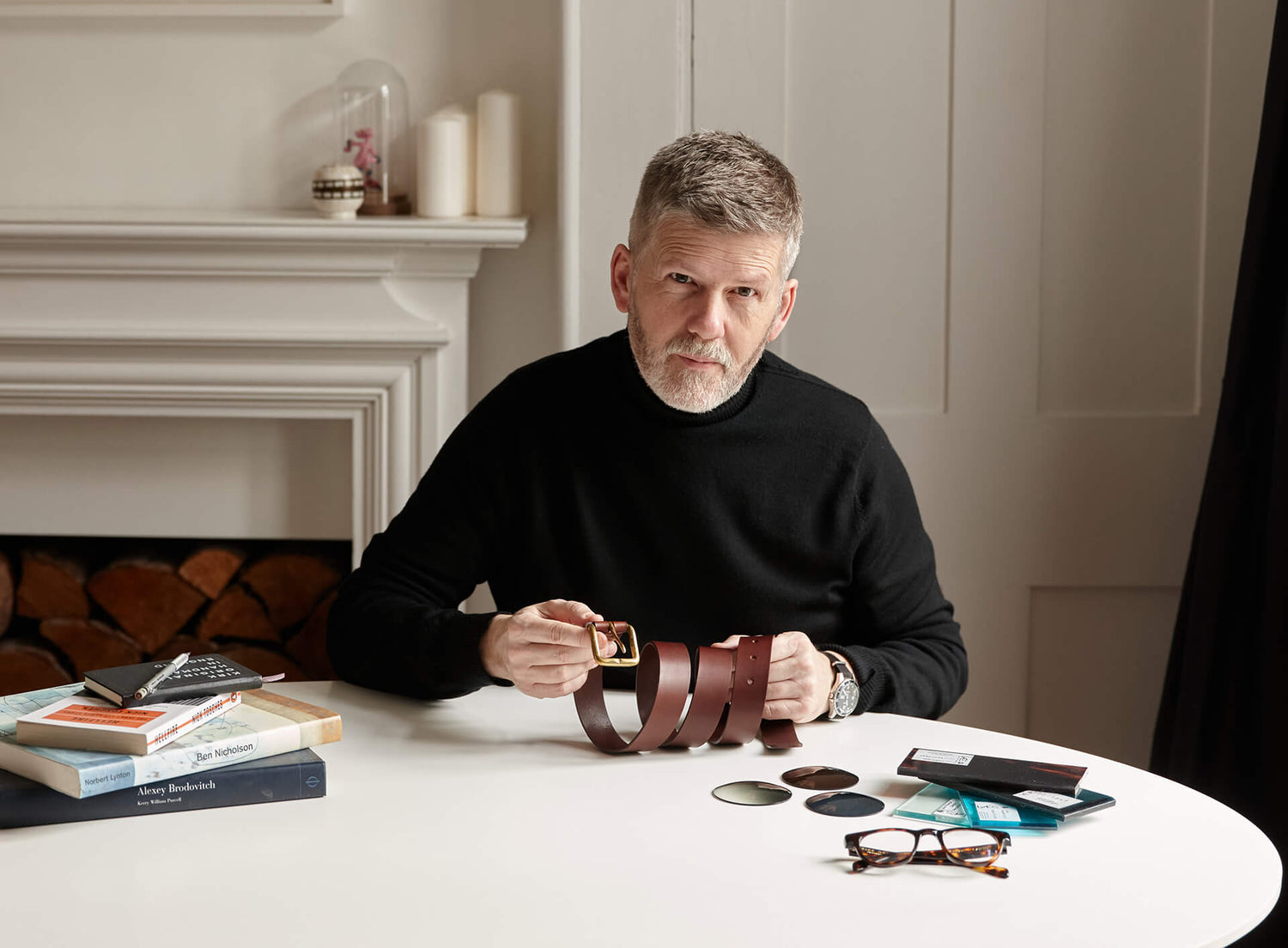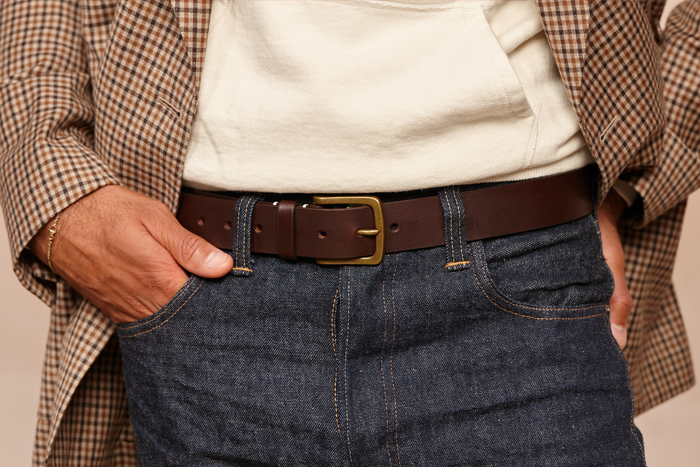Mark Brown is what you’d call an old-school creative who looks at the world through a modern lens. With seemingly more hours in the day available to him than the average man, he spends his time between heading up Author, a London-based design agency that caters to the luxury retail market, and as creative director of Kirk Originals, which is one of the world’s coolest and most respected eyewear brands that we’ve come to admire for its commitment to Made in England manufacturing.
With a wealth of knowledge on all things design-related, we could think of no one better to profile in our series of designer profiles. Here’s what he had to say.

Let’s start from the beginning! What was it like growing up in Northern Ireland and how did you find your way into the design world?
The 1970’s and 1980’s in Northern Ireland was the peak of what the world knew as “The Troubles”. The reality of day to day growing up bore very little relation to what was portrayed on news channels – it was very similar to that of every other kid or teenager of that time just with an added element of caution and danger in the mix. There were three elements during this period that shaped my future. Firstly, an aspirational working-class fixation on a good education through Grammar School. Secondly, an introduction to men’s retail working on the shop floor of a gentleman’s outfitters from the age of 14 to 17. Thirdly, being in and around building sites and joinery shops from a “wee boy” through to becoming a teenager and gaining a love and understanding for those who build, make and craft buildings and objects. I would say that those three strands combined to shape all of my future journeys in design.
Tell us about Author? What is it that your business specialises in and what makes it different?
Author is a design agency working with both fashion retailers and hospitality brands. We have a team of designers and architects who create new concepts and deliver spaces. We have a real passion for old fashioned retail values such as customer service and a love for the social aspect of shopping. With a strong focus on craft, detail and materiality, our client list includes Acne Studios, Edward Green, Barker Shoes, Lotus Cars and The Crown Estate.
Retail has had a tough time in recent years due to the ease of online shopping. In your opinion, where did it go wrong and lose its touch?
Too many retailers overstretched their store portfolios and allowed their spaces to become tired, uninspiring and staffed by people who really didn’t care about customer service. That made it easy for the internet to steal customers. But I’m really excited about physical retail now. There are some phenomenal new concepts and experiences appearing globally with a sense of wonder and service at their core. We are now entering a new golden era for physical stores.
Following on from that, how do you go about creating new experiences for customers that they will remember?
Your target customer needs to be at the heart of everything you do. Put service at the core of everything and second guess what your customer wants before they even know they need it. Create spaces that have sustainability as a given but are built for change, flexibility and ongoing excitement. Think of your space as a showcase for your overall brand rather than as a home for stock and layer in the opportunity for community and a sense of belonging through a continuous programme of events, demonstrations and experiences.
Now to Kirk Originals. Why did you want to rejuvenate this iconic eyewear brand?
Kirk Originals had been a brand that was very much part of the early 90’s style story in London and had been worn by key faces in that period. It appeared regularly in the style press like Arena and The Face. However, it had subsequently drifted into a wider and slightly off key European style direction, losing its link to London Culture and its Made in England roots. We saw an opportunity to go back and embrace that early 90’s standpoint and re-connect the brand with its original point of view.

Where do you get your inspiration for eyewear design from?
I’m very wedded to the idea of heroes, anti-heroes, mentors and icons. Individuals and groups who have influenced culture, style and history from the early 1930’s through to the end of the 20th Century. There is a rich and endless archive of style directions and story-telling to dive into that I believe really resonates with a contemporary customer.
Every frame we create has to have a story behind it, a reference to a person or period of time that was significant. There’s endless opportunities to find old stories and references and to make them new again. For instance I’m working on some frames that started with uncovering a story around Peter Beard and Andy Warhol and their homes in Montauk in The Hamptons.
When it comes to your design process, how come you’ve always gone about it in the traditional way of pen and paper?
I believe you have to “feel it”. There’s a direct relationship between the brain and the hand that a computer only gets in the way of. There’s an inherent freedom and immediacy in having an idea and committing it immediately onto a scrap of paper, a napkin or a notebook. Over a period of time you amass a series of sketches and drawings in your notebook that you can revisit and refer to. It’s an ever evolving repository of ideas that have only your unique handwriting to them.
You’ve cited Robert Brownjohn, Emmett McBain and George Lois as your design heroes. Why?
This era of the 1950’s 1960’s and 1970’s was the heyday for Art Direction in Design and Advertising in the US. I love that brash confidence that these guys exuded. The notion of the “Big Idea” a simple solution unashamedly commercial while still being beautifully crafted to cut through to a wide audience while often borrowing from high brow art and culture. All delivered by guys who looked immaculate and understood that looking good was as important as thinking big.
Kirk Originals has produced some excellent collaborations in recent years, how would you describe the power of collaboration?
A great collaboration should really celebrate the best of the two parties coming together.
With Kirk, we bring a strong bold aesthetic and a love of craft in eyewear. Any partner should bring a new story to add to that. For instance our recent collaboration with The Rolling Stones indulged our love for a bold 1970’s aviator with possibly the greatest exponents of Rock’n’Roll style. Other collaborations are about positioning Kirk Originals within a new space like our frames with Overfinch where we indulged our love for the 1960’s British racing aesthetic.

In your opinion, what constitutes good design?
That’s a question that doesn’t really have a simple answer. For me it’s ultimately about balance and proportion. You can have an object that’s beautifully pared back and minimally designed by Dieter Rams or garish, expressive and wild by Alessandro Michele. Both can work equally well as long as the proportion and balance are just right. In the office we call it “the eye” and it’s something you can attain over the years or just have inherently. That notion that something’s just right or not simply by glancing at it and feeling if it's correct.
Can you tell us about your workshop and what makes it so special?
First off it’s about the people. Our master craftsman was actually an apprentice when Kirk Originals was started in the early 90’s, so I love that link with the brand's past.
Then there’s its location in an essentially English and character laden part of the UK.
It’s a business firmly rooted in its town. The space itself feels like it’s part of a bygone era with years and years of a built up patina and its workbenches and machinery worn in and down from years of use by hand. There’s an atmosphere when you enter that it has years of knowledge and experience in the air. It's undefinable but it’s an emotion that you just feel.
How important is Made in England to you?
For me it’s a core part of the brand. Not for any jingoistic reasons but for the fact that I’m able to work face to face with skilled crafts people rather than via Zoom and Email. Keeping it more local works from a sustainable footprint point of view and as Kirk Originals grows we want to work with our small factory to assist them in training new makers for tomorrow. But I also believe that we shouldn’t be entirely wedded to only working in England. It’s important to embrace new smart production methods and materials and search those out globally. There’s no reason why the idea of Made in England and Made in Italy, for instance, can't coexist with hybrid production methods and crossover of skills.
How are you getting on with your Awling belt and what were your first impressions?
Absolutely love the simplicity and quality of my Awling belt. What’s instantly noticeable is the touch and feel of the manufacture and materials used. These aren’t always conveyed through product photography but they do become instantly apparent when you have the belt in your hand and there’s an indefinable sense of weight and quality. This is a belt that will gain character through wear over the years making it a long term object of beauty.





Leave a comment
This site is protected by hCaptcha and the hCaptcha Privacy Policy and Terms of Service apply.